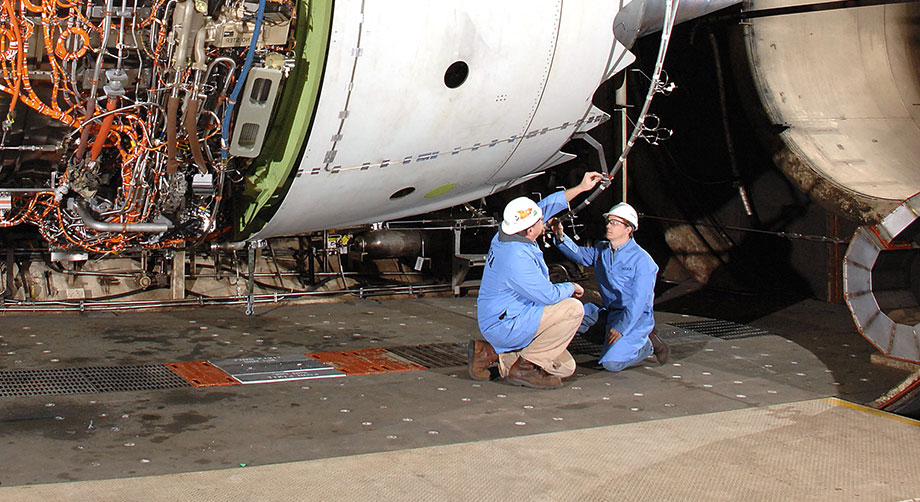The Top 10 Best-Paying Mechanical Science Trades
The Top 10 Best-Paying Mechanical Science Trades
Attending a trade school that has classes in mechanical sciences areas is a great way to learn skills and prepare for a well-paying job in an area that is of interest to you. In fact, many of the career skills taught in trade school programs can lead to jobs that pay $25 an hour or more after you graduate!
Another positive feature of a trade school is that you can get a high-quality education and fast training. Some schools and programs even allow students to graduate with certificates in as few as ten weeks.
Many professionals working in skilled trades report a high level of job satisfaction too, and these are often people who attended trade schools for programs related to mechanical sciences.
To help you decide if the mechanical sciences might be right for you, the Imagine America Foundation has created a list of the top ten best-paying jobs in mechanical science trades—using data from the Bureau of Labor Statistics (BLS)*.
Check it out and see if the job you’ve been dreaming of is included!
1.Construction Manager
2018 Median Pay: $93,370 per year/$43.89 per hour
Entry-Level Education: Bachelor’s degree
Typical Job Duties: Construction managers plan, coordinate, budget, and supervise construction projects from start to finish.
Work Environment: Many construction managers have a main office but spend most of their time working out of a field office at a construction site, where they monitor the project and make daily decisions about the project’s activities. The need to meet deadlines and respond to emergencies often requires construction managers to work overtime, nights and weekends, or holidays.
Job Outlook through 2028: 10% growth (faster than average)
Construction Manager Fun Fact: While you may think that being a construction manager is a job best suited for men, that’s just a gender stereotype. The fact is that more and more women are entering the construction field as they earn degrees in architecture and engineering.
2. Aircraft and Avionics Technician
2018 Median Pay: $65,330 per year/$31.41 per hour
Entry-Level Education: Associate degree or postsecondary certificate
Typical Job Duties: Aircraft and avionics equipment mechanics and technicians repair and
perform scheduled maintenance on aircraft.
Work Environment: Aircraft and avionics equipment mechanics and technicians work in hangars, in repair stations, or on airfields—which can often be loud due to the presence of aircraft engines and equipment.
Job Outlook through 2028: 3% growth (slower than average)
Aircraft and Avionics Technician Fun Fact: Airfields, hangars, and repair stations are the most common places for aircraft and avionics technicians to work. Most technicians and mechanics find jobs in these types of facilities in cities where major airports and cities are located. Living in areas with high-travel traffic helps aircraft and avionics technicians better secure employment.
3. Boilermaker
2018 Median Pay: $62,150 per year/$29.88 per hour
Entry-Level Education: Postsecondary certificate or formal apprenticeship
Typical Job Duties: Boilermakers assemble, install, maintain, and repair boilers, closed vats, and other large vessels or containers that hold liquids and gases.
Work Environment: Boilermakers perform physically demanding work. They may travel to worksites and be away from home for extended periods.
Job Outlook through 2028: 6% growth (as fast as average)
Boilermaker Fun Fact: The job of a boilermaker dates all the back to 10 AD and actually evolved from industrial blacksmithing. While the name implies that they only work with boilers, they work with many different vessels.
4. Electrician
2018 Median Pay: $55,190 per year/$26.53 per hour
Entry-Level Education: Postsecondary certificate or formal apprenticeship
Typical Job Duties: Electricians install, maintain, and repair electrical power, communications,
lighting, and control systems.
Work Environment: Almost all electricians work full-time. Work schedules may include evenings and weekends, and overtime is common.
Job Outlook through 2028: 6% growth (as fast as average)
Electrician Fun Fact: While there are many levels of proficiency that an electrician can achieve, the highest (and most well-regarded) is a master electrician. The few who earn the title have received both classroom and hands-on training for many years. After working on the job for at least three years, those who are interested can apply to be a master electrician; their credentials and skills are reviewed by other master electricians in the field. Most master electricians spend as much time in school and receiving hands-on training as some doctors.
5. Wind Turbine Technician
2018 Median Pay: $54,370 per year/$26.14 per hour
Entry-Level Education: Postsecondary certificate
Typical Job Duties: Wind turbine service technicians install, maintain, and repair wind turbines.
Work Environment: Wind turbine service technicians generally work outdoors, in confined spaces, and often at great heights. Although the majority of wind techs work full-time, they may also be on call to handle emergencies during evenings and weekends.
Job Outlook through 2028: 57% growth (much faster than average)
Wind Turbine Technician Fun Fact: Wind energy was first used in ancient China around the year 2000 BC. Today, Germany uses the most wind energy per year. It is often hard for countries to use wind turbine energy due to its high cost to produce.
6. Plumber or Pipefitter
2018 Median Pay: $53,910 per year/$25.92 per hour
Entry-Level Education: Postsecondary certificate
Typical Job Duties: Plumbers, pipefitters, and steamfitters install and repair pipes that carry liquids or gases.
Work Environment: Plumbers, pipefitters, and steamfitters work in factories, homes, and businesses—and any other places where there are pipes or septic systems. Plumbers are often on call for emergencies, so evening and weekend work is common.
Job Outlook through 2028: 14% growth (much faster than average)
Plumber or Pipefitter Fun Fact: Being a plumber is not only a handy skill to have, but it can also save you a ton of cash. A leaky faucet that drips just once per second can waste more than 3,000 gallons of water a year. That’s a lot of cash wasted down the drain!
7. Millwright
2018 Median Pay: $51,630 per year/$24.82 per hour
Entry-Level Education: Postsecondary certificate
Typical Job Duties: Industrial machinery mechanics, machinery maintenance workers, and
millwrights install, maintain, and repair factory equipment and other industrial machinery.
Work Environment: Millwrights typically spend their time in manufacturing facilities. However, they may also regularly be on call, work night or weekend shifts, or work overtime.
Job Outlook through 2028: 5% growth (as fast as average)
Millwright Fun Fact: Many millwrights also have certification and skills in the area of welding. This helps them better serve their customers by being able to create the materials that their clients need.
8. Construction Equipment Operator
2018 Median Pay: $46,990 per year/$22.59 per hour
Entry-Level Education: Postsecondary certificate
Typical Job Duties: Construction equipment operators drive, maneuver, or control the heavy machinery used to construct roads, buildings, and other structures.
Work Environment: Construction equipment operators work in nearly all weather conditions. They often get dirty, greasy, muddy, or dusty. The majority of operators work full-time, and some operators have irregular work schedules. Some construction projects, especially road building, are done at night.
Job Outlook through 2028: 10% growth (faster than average)
Construction Equipment Operator Fun Fact: A bulldozer is a common heavy equipment vehicle used by construction equipment operators. While every machine varies in horsepower, weight, and price, the average has over 300 horsepower, weighs more than 40 tons, and cost more than $250,000 to buy!
9. Machinists and Tool and Die Makers
2018 Median Pay: $44,950 per year/$21.61 per hour
Entry-Level Education: Postsecondary certificate
Typical Job Duties: Machinists and tool and die makers set up and operate machine tools to produce precision metal parts, instruments, and tools.
Work Environment: Machinists and tool and die makers work in machine shops, toolrooms, and factories. Although many work full-time during regular business hours, overtime may be common, as is evening and weekend work.
Job Outlook through 2028: 1% growth (little to no change)
Machinists and Tool and Die Makers Fun Fact: Tool and die makers not only have an expert knowledge of making parts, they also have extensive training and knowledge in reading blueprints, measurement techniques, math, and machine assembly. These skills come from years of on-the-job training and classroom education.
10. Masonry Worker
2018 Median Pay: $44,810 per year/$21.54 per hour
Entry-Level Education: Postsecondary certificate or formal apprenticeship
Typical Job Duties: Masonry workers use bricks, concrete blocks, concrete, and natural and manmade stones to build masonry structures.
Work Environment: The work is physically demanding because masons lift heavy materials and often must stand, kneel, and bend for long periods. Poor weather conditions may reduce work activity because masons usually work outdoors, though most masons do work full-time.
Job Outlook through 2028: 11% growth (much faster than average)
Masonry Worker Fun Fact: Across the world, more than 70% of the buildings constructed are
made of masonry. This is largely because masonry is a very stable building material: it’s resistant to fire, earthquakes, and sound.
Depending on who you ask, the definition of a skilled trade will vary. But most consider it to be a job that requires a specific set of high-level skills. The jobs listed here require hands-on training and, often, classwork to learn the proper way to perform the necessary skills. Those who complete their training and earn a certificate or degree can find themselves well prepared to take on all the tasks that will be required of them on the job.
While the definition of a trade may differ depending who you talk to, one thing that all employers can agree on is that there are plenty of trade school jobs out there for those who are well qualified. Those who have earned entry-level credentials can quickly find themselves in a great starting point on the career path of their choice. And for more experienced workers, adding on additional credentials and certificates can be a great way to move up the career ladder while also making more money.
The possibilities are very nearly endless, and many career training programs can be completed in a short amount of time depending on the next career step you desire to take. Learn more about trade schools and the opportunities at the Imagine America Foundation!
* Bureau of Labor Statistics, U.S. Department of Labor, Occupational Outlook Handbook; website accessed on January 28, 2019.
More on Mechanical Science Careers
Let’s Talk Picking the Right Trade School with Universal Technical Institute
Let’s Talk Picking the Right Trade School with Universal Technical Institute: SEASON 5, EPISODE 3 MORE FROM OUR EPISODE ON picking the right career school with universal technical institute Find Your Perfect Training Program At UTI, our mission is to prepare technicians for the careers…
Let’s Talk Women in Welding with Tulsa Welding School
Let’s Talk Women in Welding with Tulsa Welding School: SEASON 5, EPISODE 2 MORE FROM OUR EPISODE ON Women in welding WITH tulsa welding School Contact TWS — Houston, TX Click Here For A Virtual Tour! Location 243A Greens Rd. Houston, TX 77060 Contact tulsa…
Let’s Talk Aviation with Spartan College of Aeronautics and Technology
Let’s Talk Aviation with Spartan College of Aeronautics and Technology: SEASON 5, EPISODE 1 MORE FROM OUR EPISODE ON aviation CAREERS WITH SPARTAN COLLEGE OF AERONaUTICS AND TECHNOLOGY Contact Spartan College — Tulsa Main Campus Click Here For A Virtual Tour! Location 8820 East Pine…
Leave a Reply Cancel reply
- - ADVERTISEMENT - -
Categories
- Alumni Series (13)
- Automotive (57)
- Aviation (15)
- Business (14)
- Business & Arts (18)
- Career College Expositions (7)
- Career Development (96)
- CCC Blog (1)
- CCC Podcast (9)
- College Resource (90)
- College Showcase – Lincoln Tech (6)
- College Showcase – New Jersey (8)
- College Showcase – Pennco Tech (1)
- College Showcase – Universal Technical Institute (2)
- Continuing Education (154)
- Cosmetology (3)
- Counselor Resources (108)
- Criminal Justice (3)
- Dental Assistant (2)
- Education (109)
- Financial Literacy (17)
- Health Sciences (50)
- Heritage Series (3)
- High School Recruitment Series (4)
- Housing Series (10)
- HVAC (8)
- Imagine America Scholarships (12)
- Information Technology (17)
- Massage Therapy (5)
- Mechanical Sciences (109)
- Medical Assistant (12)
- Millennial Student Series (4)
- News (11)
- Nursing (22)
- Online education (13)
- Pandemic Proof Series (4)
- Personal Finance (17)
- Podcast (90)
- Research (11)
- Road Map Series (2)
- Scholarships (12)
- Social Media Series (4)
- Strata Tech (3)
- Student Success (29)
- Study Tips (3)
- Time Managment (1)
- Top 10 (10)
- Trucking (2)
- Uncategorized (14)
- Universal Technical Institute (19)
- Veteran Affairs (8)
- Welding (24)
- Women in Skilled Trades (3)
Tags
- - ADVERTISEMENT - -






